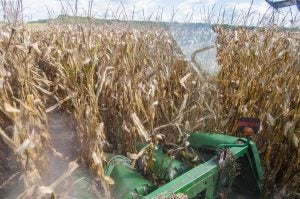Due to the hardy, fibrous composition of cornstalks, farmers are left every year after harvest having to decide on how to reduce corn residue in their fields. What are the best ways to get the most out of the entire corn plant — instead of just the kernel? Rather than viewing the residue as a hindrance, corn residue can be helpful in making sure next year leads to a good harvest. Farmers have proven to be creative when it comes to utilizing the entirety of everything that they harvest.
While some farmers may leave their stalks upright after harvest to help catch snowfall, they can face problems in the spring when they plant or fertilize for the next harvest by stalks being in the way of farming implements. A popular compromise to leaving the whole stalk is to chop it down to a height of 12 to 18 inches during harvest. This allows the shortened stalks to collect snowfall and cuts down on soil erosion, as well as keeps the corn residue in place, allowing for quicker breakdown of the residue into the soil. Residue breakdown in the soil is important to farmers because it helps maintain or improve the organic matter in the soil. If organic matter is lost in the soil, yields per acre will go down in future harvests as nutrients are lost.
There are two primary uses of leftover residue for livestock benefit: grazing cattle on the leftover residue and baling the residue for bedding.
Grazing cattle on the residue helps prolong feeding hay to the cattle. This is cost-effective because the cattle are helping eliminate the possibility of residue buildup on the field, while also eating fodder that has already been paid for through crop production and helping put nutrients back in the fields through manure.
Because the most palatable part of the residue is also the most nutritious, cattle will start eating the most nutritious part of the plant and end with the least nutritious part, the stalk. If the farmer is grazing fall calving cows, they may want to supplement with extra energy and protein, but ideally, a mineral supplement is the only supplement needed for grazing corn residue. Nitrate poisoning is also something to be aware of. The bottom 18 to 24 inches of stalk is the part of the plant that hold the highest nitrate concentration. Since that is the last part of the plant the cattle eat, it is not a big concern. Ensuring that the cattle are rotated off the field before they consume the very end of the plant is an easy way to avoid nitrate toxicity. If the farmer doesn’t have cattle, renting the field to be grazed down by a producer who has cattle can be another source of income that benefits both parties.

Baling and selling the stalks for bedding as straw can be a profitable way to clean up the field of residue. This may be an attractive idea to a farmer who already has the equipment needed to bale the stalks, leaving their upfront costs as only labor and fuel. However, baling can deplete the ground of nutrients and leave the ground more susceptible to erosion. Because of this, completely removing the residue should not be done every year, and a portion of the rows should be left up to leave some residue and nutrient recycling back into the soil.
While this may seem counterintuitive, planting cover crops in the corn fields will help breakdown corn residue. Cover crops help recycle nutrients back into the soil, reduce water runoff, increase water infiltration, and reduce erosion. Humidity from the cover crop canopy aids in the residue breakdown and can contribute to warming the soil in the spring. Things to consider with a cover crop is how easy it will be able to break up in the spring. A cover crop with a fibrous root system will be harder to break up and, if not controlled in a timely manner, could dry out the field or create more residue on the field. While cover crops can cost more upfront for seed and labor, it provides an option to graze livestock on winter grass or harvest the cover crop to sell.
Tilling is another option to help speed up corn residue breakdown. While different types of tilling have different effects on the field, one thing all tilling has in common is that it has a higher production cost with labor and fuel than those practicing a no-till method. There are both low- and high-disturbance methods of tilling, depending on what the farmers want the results to be. Low-disturbance tilling mainly chops up pieces of the residue and only breaks up the first 2 to 3 inches of soil. High-disturbance tilling disturbs the soil to the point that it is tossed in with the residue and creates more horizontal movement of the soil. The soil meeting the residue will introduce soil microbes to the residue, helping with decomposition. By mixing the soil and residue together, the residue doesn’t create a barrier for soil warming. However, because the soil and residue become mixed together, the ground becomes more susceptible to water and wind erosion.
Different systems work for different farmers and different geographical areas. Farmers decide what is best for their operations and conservation systems. Weather, soil type, farm size, fertilization practices, and crop production scale all help determine what method of residue reduction to choose.
Rebecca Sherwood is Kentucky-born and Texas-raised and has worked as an editor for the USDA. She earned her degree in animal science from Texas A&M University.



